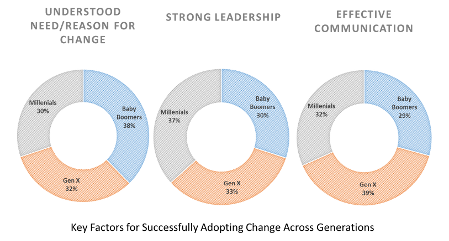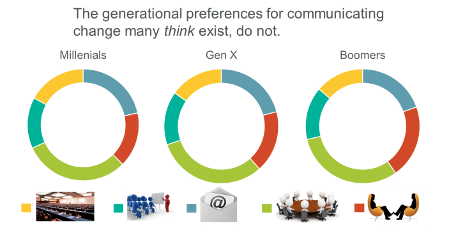Managing Change in the Shifting Broadcast Environment
ARLINGTON, VA.—The broadcast industry continues to undergo change at an increasing and dramatic pace. Much of that change is driven by rapid technology advances that lead to an increasing number of ways for users to find, receive and consume content. This is ultimately good for business, particularly for organizations that recognize and embrace change as part of their DNA.
Along with these changes in capabilities and consumption, we are also undergoing paralleled generational changes in our workforce. We are seeing, deeply diverse multigenerational workforces—more so than ever before. According to labor and workforce data compiled from the most recent Current Population Survey (CSP, a joint effort of the U.S. Census Bureau and the U.S. Bureau of Labor Statistics), the employment group with the highest percentage of young professionals encompasses the media and entertainment industry, where 36.3 percent of the professional workforce was between the ages of 20 and 34. How big of a factor is the workforce shift for media and tech companies? Do we need to meet the unique needs of each generational group or does one size fit all? Companies that get this right are uniquely positioned, and those that do not risk losing their best talent to competitors or other industries that “get it.”
There are several areas of change across our industry that require attention, and in-turn offer high potential in the form of return-on-investment and productivity including:
·Non-broadcast adjuncts to the traditional distribution model,
·Transition to IT, IP, cloud and service-based infrastructure and architecture,
·Social media platforms and engagement,
·ATSC 3.0 and enhanced broadcast services, and
The professional video industry's #1 source for news, trends and product and tech information. Sign up below.
·Outflow of broadcast technology subject matter experts (particularly those with RF and transmission skills).
The big question is whether your organization can simultaneously navigate these new opportunities and corresponding challenges so it can remain competitive and thrive into the future. Leading staff through periods of change is one of the most daunting workplace challenges management will encounter. And organizations that best lead their people through change will fare far better than those that do not. Ultimately, when there is understanding, dialogue, trust and strong management, employees are motivated and inspired to thrive during change.
CHANGE IS CHANGE ACROSS GENERATIONS
As shown in the CSP data (Fig. 1), the makeup of the media and tech workforce is shifting as Baby Boomers (age 52-71) retire and companies become more dominated by Generation X (age 36-51) and Millennial (age 18-35) employees. How does this changing mix affect strategies and success factors as we undergo industry change? Eagle Hill Consulting conducted a nationwide survey across multiple industries and generations, polling employed respondents about their experiences undergoing workplace change.

Interestingly, the key factors for successfully adopting change across generations varied little across these groups. Regardless of their generation, respondents identified three key important factors in successful change initiatives: understanding the need for change, strong leadership and effective communication.
In simple terms, managers facing complex change initiatives can be most successful if they focus on:
·Exhibiting strong leadership,
·Practicing effective communication, and
·Understanding how leadership and communication during change are different from day-to-day activities and approaches.
LEADERSHIP & COMMUNICATION MATTER
Change leaders must build a compelling case for change and a vision for the outcome of changes. Respondents from each generational group identified failure to exhibit strong leadership as the top reason for failed change initiatives, and 89 percent of happier employees post-change attributed success to strong and visible leadership.
Poor communication of the rationale for change and poor communication overall were noted as the top reasons that organizational changes fail. Managers should focus on successfully building the case for change as well as alleviating uncertainty amongst employees during change initiatives.

Generational stereotypes are common when considering methods of communication, for example, the stereotypes that Millennials’ prefer technology-based communication while Baby Boomers’ prefer face-to-face meetings. Our survey suggests that the generational preferences for communicating change that many think exist, do not (Fig. 2). Respondents showed that 70 percent of each generational group prefers some form of in-person communication over email during change. Further, every respondent—regardless of generation—wanted more in-person communication than they received during a period of change. Fewer than 1 in 5 said that email is their preferred method for receiving communications during a change.
UNDERSTANDING MILLENNIALS
While Eagle Hill’s survey debunked many of the myths of dramatic differences between generational groups, two results are useful to understand as Millennials begin to make up an ever-growing segment of the workforce. Making a strong case for change and driving momentum are especially important to this generational group:
Communication: Most Millennial respondents (68 percent) were happier than any other generation (Gen X: 53 percent; Baby Boomers: 54 percent) about a change when they understood the case for change.
Momentum: Maintaining momentum through change is also key. Sixty percent of Millennials who were unhappy after a change effort said they started off excited. Generating quick wins and maintaining regular communication can help engage Millennials over time.
TAKE-AWAYS
Your business is changing. Whether it’s dealing with adding new distribution outlets, changing to an IP infrastructure, exploring cloud and service-based options, thinking about implementing ATSC 3.0, or whatever, understanding the implications of change on people is critical if you want to succeed. So, as you contemplate implementing organizational changes to align with the future, be sure to consider the following:
·Communicating organizational change is a distinct process,
·Multigenerational workforces want change communicated in similar ways,
·In-person communication during organizational change is critical, and
·Generational differences exist when considering “what” to communicate.
Concentrating on leadership and communication makes all the difference in leading organizations and workers of all ages through times of significant change.
John McCoskey is Industry Lead Executive - Communications, Media & Technology at Eagle Hill Consulting in Arlington, VA. He can be reached atjmccoskey@eaglehillconsulting.com.
